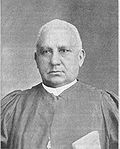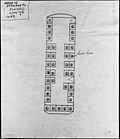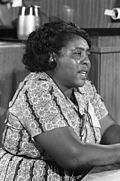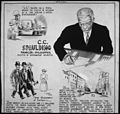Joseph Carne-Ross
The civil rights movement portal The civil rights movement was a social movement in the United States from 1954 to 1968 which aimed to abolish legalized racial segregation, discrimination, and disenfranchisement in the country, which most commonly affected African Americans. The movement had origins in the Reconstruction era in the late 19th century, and modern roots in the 1940s. After years of nonviolent protests and civil disobedience campaigns, the civil rights movement achieved many of its legislative goals in the 1960s, during which it secured new protections in federal law for the civil rights of all Americans. Following the American Civil War (1861–1865), the three Reconstruction Amendments to the U.S. Constitution abolished slavery and granted citizenship to all African Americans, the majority of whom had recently been enslaved in the southern states. During Reconstruction, African-American men in the South voted and held political office, but after 1877 they were increasingly deprived of civil rights under racist Jim Crow laws (which for example banned interracial marriage, introduced literacy tests for voters, and segregated schools) and were subjected to violence from white supremacists during the nadir of American race relations. African Americans who moved to the North in order to improve their prospects in the Great Migration also faced barriers in employment and housing. Legal racial discrimination was upheld by the Supreme Court in its 1896 decision in Plessy v. Ferguson, which established the doctrine of "separate but equal". The movement for civil rights, led by figures such as W. E. B. Du Bois and Booker T. Washington, achieved few gains until after World War II. In 1948, President Harry S. Truman issued an executive order abolishing discrimination in the armed forces. In 1954, the Supreme Court struck down state laws establishing racial segregation in public schools in Brown v. Board of Education. A mass movement for civil rights, led by Martin Luther King Jr. and others, began a campaign of nonviolent protests and civil disobedience including the Montgomery bus boycott in 1955–1956, "sit-ins" in Greensboro and Nashville in 1960, the Birmingham campaign in 1963, and a march from Selma to Montgomery in 1965. Press coverage of events such as the lynching of Emmett Till in 1955 and the use of fire hoses and dogs against protesters in Birmingham increased public support for the civil rights movement. In 1963, about 250,000 people participated in the March on Washington, after which President John F. Kennedy asked Congress to pass civil rights legislation. Kennedy's successor, Lyndon B. Johnson, overcame the opposition of southern politicians to pass three major laws: the Civil Rights Act of 1964, which prohibited discrimination based on race, color, religion, sex, or national origin in public accommodations, employment, and federally assisted programs; the Voting Rights Act of 1965, which outlawed discriminatory voting laws and authorized federal oversight of election law in areas with a history of voter suppression; and the Fair Housing Act of 1968, which banned housing discrimination. The Supreme Court made further pro–civil rights rulings in cases including Browder v. Gayle (1956) and Loving v. Virginia (1967), banning segregation in public transport and striking down laws against interracial marriage. (Full article...) Selected article -The Birmingham campaign, also known as the Birmingham movement or Birmingham confrontation, was an American movement organized in early 1963 by the Southern Christian Leadership Conference (SCLC) to bring attention to the integration efforts of African Americans in Birmingham, Alabama. Led by Martin Luther King Jr., James Bevel, Fred Shuttlesworth and others, the campaign of nonviolent direct action culminated in the 1963 Children's Crusade, widely publicized confrontations between young black students and white civic authorities, and eventually led the municipal government to change the city's discrimination laws. In the early 1960s, Birmingham was one of the most racially divided cities in the United States, enforced both legally and culturally. Black citizens faced legal and economic disparities, and violent retribution when they attempted to draw attention to their problems. Martin Luther King Jr. called it the most segregated city in the country. Protests in Birmingham began with a boycott led by Shuttlesworth meant to pressure business leaders to open employment to people of all races, and end segregation in public facilities, restaurants, schools, and stores. When local business and governmental leaders resisted the boycott, the SCLC agreed to assist. Organizer Wyatt Tee Walker joined Birmingham activist Shuttlesworth and began what they called Project C, a series of sit-ins and marches intended to provoke mass arrests. (Full article...) General imagesThe following are images from various civil rights movement-related articles on Wikipedia.
Related portalsWikiProjectsSelected biography -Viola Fauver Liuzzo (née Gregg; April 11, 1925 – March 25, 1965) was an American civil rights activist in Detroit, Michigan. She was known for going to Alabama in March 1965 to support the Selma to Montgomery march for voting rights. On March 25, 1965, she was shot dead by three Ku Klux Klan members while driving activists between the cities and transportation. Also in the pursuit car was an undercover informant working for the Federal Bureau of Investigation (FBI). His role in this and other events was not revealed until 1978. To deflect attention from the FBI, its head J. Edgar Hoover made defamatory claims about Liuzzo. (Full article...) Selected image - Civil rights activists stage a sit-in at Woolworth's in Durham, NC to protest against racial segregation. (10 February 1960)
Did you know?
TopicsSubcategoriesThings to doAssociated WikimediaThe following Wikimedia Foundation sister projects provide more on this subject:
Discover Wikipedia using portals
|

 Read
Read
 AUTHORPÆDIA is hosted by Authorpædia Foundation, Inc. a U.S. non-profit organization.
AUTHORPÆDIA is hosted by Authorpædia Foundation, Inc. a U.S. non-profit organization.





















































